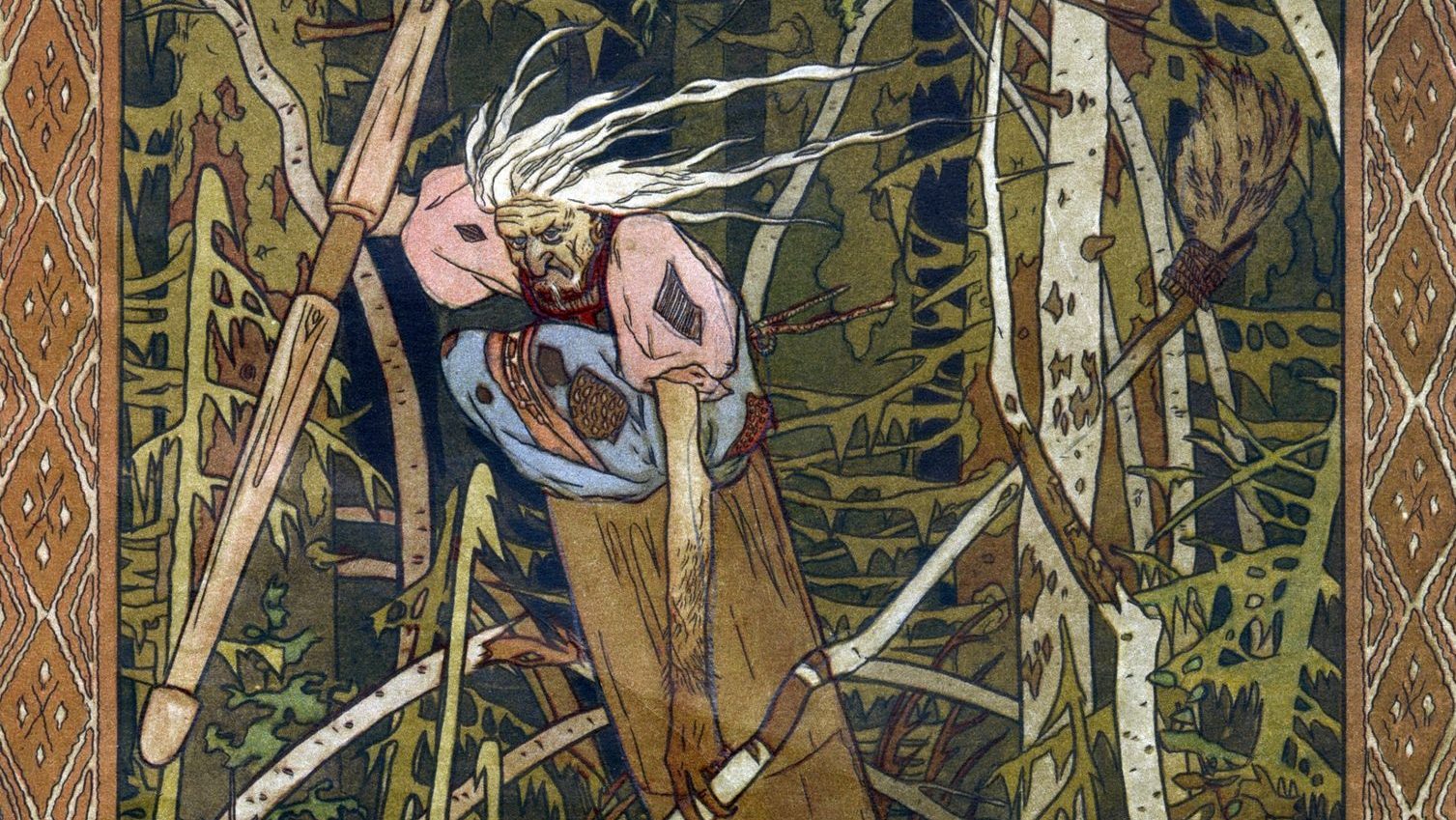While children here look forward to a visit from Father Christmas, in the Slavic states of Europe it is Father Frost who is the bestower of presents on Christmas Eve. Often accompanied by his granddaughter, the Snow Maiden, Father Frost has a lot of ground to cover, from the Tatra Mountains of Slovakia to the Arctic wastes of northern Russia.
The similarities between Father Christmas and Father Frost are many, even down to the big white beard, but one key way in which they differ is that Father Christmas is not pursued on his rounds by a cannibalistic witch in a flying pestle and mortar who lives in a house built on a giant pair of chicken legs. Or if he is, he’s never mentioned it.
Attempting to steal children’s Christmas gifts from a kindly old man is only one item on the charge sheet of Baba Yaga, the fairytale scourge of Russia, Ukraine and Belarus. There are countless other offences to be taken into consideration in a career that goes back centuries.
Naturally she enjoys a range of regional nuance and variation, but most accounts agree that Baba Yaga is a hideous old woman with a long nose and sharp metal teeth. In some stories her nose is also made of metal, occasionally her breasts too.
Baba Yaga lives in the forest in a hut notable for how it can rise up on a giant pair of chicken’s legs and move around. At this time of year she warms herself on the stove at the centre of her dwelling which is part heater, part repository for the souls of the dead. She sleeps over it, soundly.
Most of her victims, whom she generally likes to cook and eat, are lost visitors hoping for shelter, or at least directions out of the forest. When passers-by are scarce, however, notably at Christmas when most people are at home with their families, Baba Yaga takes to her giant flying mortar, puts the pestle to work as rudder, punt and oar and heads off in search of Father Frost, his hoard of gifts and an unlimited supply of tasty children.
While Baba Yaga finds children particularly appetising, especially naughty ones, she is also partial to women, but consumes men only rarely, usually preferring aristocrats. Whoever her quarry might be, however, she likes them to be Russian. Russians have Baba Yaga salivating like nobody else and she can, she boasts, pick up their russkiy dukh, “Russian scent”, from a considerable distance thanks to her capacious hooter.
Still, if one can overlook the widespread murder and cannibalism perpetrated over the centuries, a wide reading of the tales in which she appears reveals Baba Yaga to be not actually all bad. She is kind to animals, for example, and the fauna of the forest adore her as their friend and protector. She holds the secret of the water of life and may even be Mother Earth herself. Indeed, catch her in a rare good mood and Baba Yaga can perform enormous kindnesses. In one folk tale she takes pity on an ageing, childless couple struggling to maintain their farm and provides them with 40 sons, all hatched from eggs, to help with the farm work.
Mostly, however, and particularly at this time of year, she is up to no good.
Images of Baba Yaga appear on lubki, painted wooden blocks peculiar to Russia, dating back to the 17th century and the time of Peter the Great. On some she is depicted astride a pig, fighting what appears to be a crocodile with a human face, a figure some scholars of Slavic folk tales say is Peter the Great himself, who was, among other things, renowned for his attempts to clamp down on the old folk beliefs.
The first known written reference to Baba Yaga is found in Mikhail Lomonosov’s 1755 Russian Grammar, where she appears appended to a list of Roman gods alongside their Russian counterparts. Baba Yaga, at least according to Lomonosov, has no equivalent in the classical pantheon. She is, it seems, all Slav.
The first published story featuring Baba Yaga appears in Vasili Levshin’s Russian Fairy Tales of 1780, a frightening depiction of her riding her pestle and mortar “like a galloping horse” through a sky darkened by the sheer number of ravens, kites and hens accompanying her through the air in a cacophony of screeching.
“I’ll eat well now,” Baba Yaga says of the prince she has in her sights, her eyes burning like red hot coals, “and I am very hungry”.
Alexander Pushkin opens his epic 1820 poem Ruslan and Ludmila with a nod to Baba Yaga, describing how a royal procession of knights passes a hut “on hen’s legs, as you can see”, inside which the occupant clocks a whiff of mouthwatering russkiy dukh.
“While, with Baba Yaga inside, a mortar gives that witch a ride;” Pushkin writes, “As King Koschei grows ill with gold. It’s Russia! – Russian scents unfold!”
She turns up in Gogol’s Dead Souls and has a section of Mussorgsky’s Pictures at an Exhibition devoted to her, not to mention “Baba Yaga” being the code name for Keanu Reeves’ character in the John Wick franchise, but her cultural preservation is due largely to the work of one 19th-century folklorist.
Ivan Khudiakov travelled widely through the Russian countryside collecting stories and published his first book of folk tales in 1860 at the age of 18. Soon afterwards he was exiled to Siberia as part of a group of conspirators plotting to assassinate Tsar Alexander II, his travels having opened his eyes to the plight of the serfs under Russian feudalism. He died in Siberia aged just 34, some detecting in his early death the inevitable legacy of tangling with tales of Baba Yaga.
If you ever find yourself lost in a Russian forest you will be able to tell Baba Yaga’s house by the fence surrounding it made from human bones with a gate that speaks, warning her of your arrival. Of course, the giant chicken legs on which the dwelling is perched should also be a hefty clue.
If you have reached as far as the fence it is already probably too late, but apparently Baba Yaga can be confused temporarily if you give the command, “Hut! Hut! Stand with your front to the forest and your back to me!” at which the house rises on its legs, turns 180 degrees and settles down again.
That’s the signal to run for it, but bear in mind, if the mortar doesn’t get you the pestle might. Merry Christmas.




